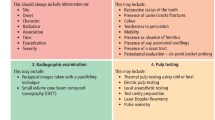Abstract
The pulp test provides a means of examining the vitality of dental pulp using physical or chemical stimulation. During electrical pulp testing, an electrical current stimulates the intradental nerve, which may be painful and stressful to patients. The study involved measurement of the electromyogram (EMG) from the anterior belly of the digastric muscle, finger movement and voice response during electrical pulp testing. The excessive stimulus time from the onset time of response (EMG, voice and finger movement) to the end of the stimulation was obtained. The results indicated that the responses occurred in the order: EMG, finger and voice. Based on these results, an automatic stimulus shut-off circuit was developed using the above-mentioned responses to stimulus during electric pulp testing. Excessive stimulus time was reduced by prompt switching-off of the pulp tester output, 64 ms on average after the first detected response (EMG). Consequently, excessive stimulus times were reduced by 284 and 152 ms on average for the subject and examiner disconnection, respectively, using the developed automatic shut-off circuit. Therefore it was possible to minimise pain and stress by reducing excessive pulp stimulation.
Similar content being viewed by others
References
Ahlquist, M. L., Edwall, L. G. A., Franzen, O. G., andHaegerstam, G. A. T. (1984): ‘Perception of pulpal pain as a function of intradental nerve activity’,Pain,19, pp. 353–366
Ahlquist, M. L., andFranzen, O. G. (1994): ‘Encoding of the subjective intensity of sharp dental pain’,Endo. Dent. Traumatol.,10, pp. 153–166
Allen, G. V., andPronych, S. P. (1997): ‘Trigeminal autonomic pathways involved in nociception-induced reflex cardiovascular responses’,Brain Res.,754, pp. 269–278
Belforte, J. E., Barcelo, A. C., andPazo, J. H. (2001): ‘Striatal modulation of the jaw opening reflex’,Brain Res.,891, pp. 138–147
Han, S. H., Yoon, S. H., Cho, Y. W., Kim, C. J., andMin, B. I. (1999): ‘Inhibitory effects of electroacupuncture on stress responses evoked by tooth-pulp stimulation in rats’,Physiol. Behav.,66, pp. 217–222
Han, Y. C., Lee, J. S., andLee, J. H. (1985): ‘Extracellular recording in trigeminal subnucleus caudalis of the anesthetized cat produced by electrical pulp stimulation’,Kor. J. Oral Biol.,9, pp. 21–29
Mahan, P. E. (1970): ‘Jaw depression elicited by tooth pulp stimulation’,Exp. Neurol.,29, pp. 439–448
Mason, P., Strassman, A., andMaciewicz, R. (1985): ‘Is the jaw-opening reflex a valid model of pain?’,Brain Res.,357, pp. 137–146
Mason, P., Strassman, A., andMaciewicz, R. (1986): ‘Intracellular responses of raphe magnus neurons during the jaw-opening reflex evoked by tooth pulp stimulation’,Brain Res.,379, pp. 232–241
Matthews, B., Baxter, J., andWatts, S. (1976): ‘Sensory and reflex responses to tooth pulp stimulation in man’,Brain Res.,113, pp. 83–94
Author information
Authors and Affiliations
Corresponding author
Rights and permissions
About this article
Cite this article
Nam, K.C., Lee, S.J., Song, C.G. et al. Automatic stimulus breaker for electric dental pulp tester using pain response. Med. Biol. Eng. Comput. 43, 375–378 (2005). https://doi.org/10.1007/BF02345815
Received:
Accepted:
Issue Date:
DOI: https://doi.org/10.1007/BF02345815




